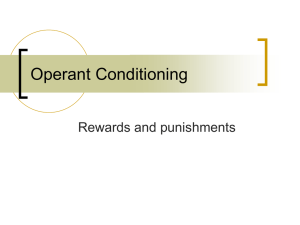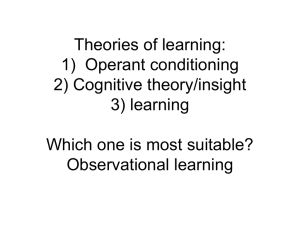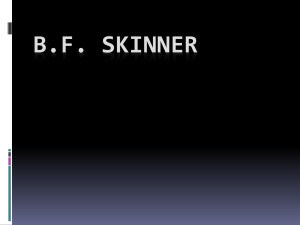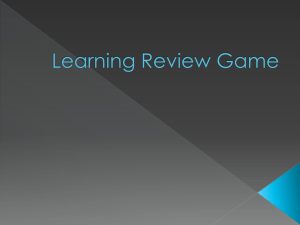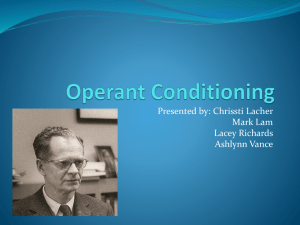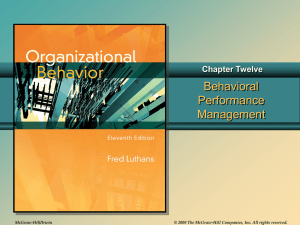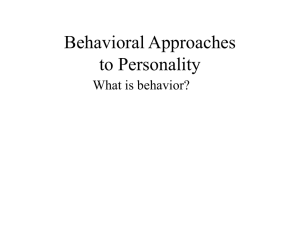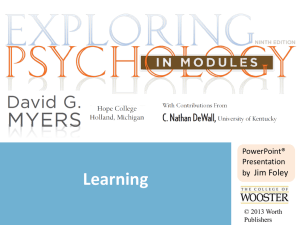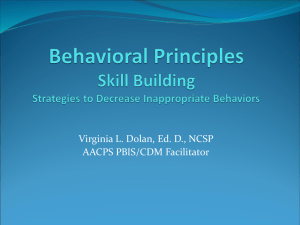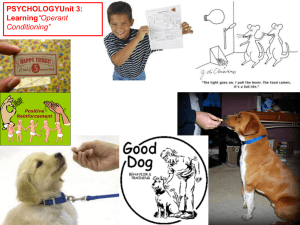OPERANT CONDITIONING
advertisement
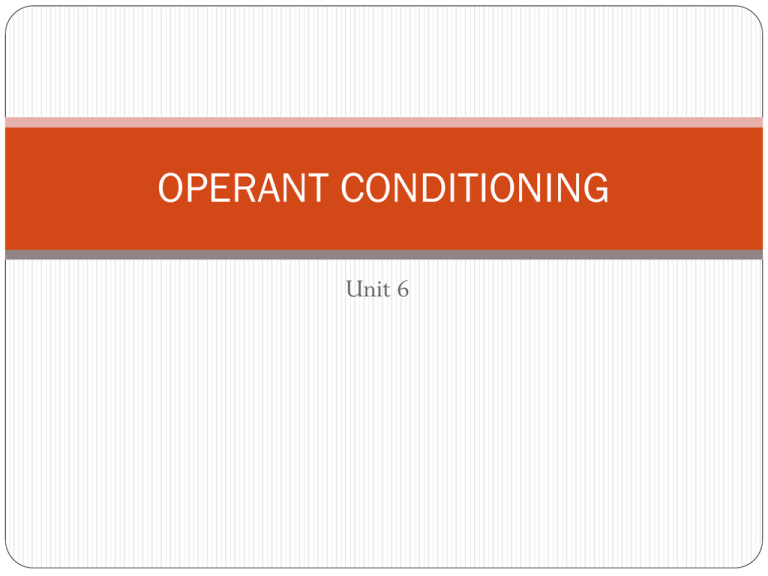
OPERANT CONDITIONING Unit 6 Sensitivity to Punishment & Rewards Punishment Score= Add all of your Yes responses for each ODD number High punishment You’ll have a range from 0-24 score you are likely vulnerable to anxiety Reward Score= Add all of your Yes responses for each EVEN High reward score number you are likely vulnerable to You’ll have a range from 0-24 impulsivity Objective 4: Applications of Classical Conditioning John Watson and Baby Albert http://www.youtube.com/ watch?v=FMnhyGozLyE Little Albert Objective 5: Operant Conditioning Classical Conditioning behavior that occurs as an automatic response to some stimulus (you have no control) Operant conditioning Associate your own actions with consequences (you have control over behavior) What determines your behavior? When does this happen? Do you care about future consequences? -reverse #s3,4,5,9,10,11,&12 - Total all 12 - Range from 12-60 - Higher numbers indicate greater concern for future consequences - Optimistic, hopeful, recycle, internal locus of control, concern for health, don’t smoke - Lower numbers tend to be very passionate about things currently going on in life - Tend to live in the here-and-now http://www.youtube.com/w atch?v=x3S0xS2hdi4 Marshmallow Test 1. How would you classically condition a preschool child who is afraid of dogs to enjoy playing with a neighbor’s friendly dog? Be sure to identify the US-UR-CS-CR along with your explanation. 2. Mr. Bryne can’t understand why scolding his 7th grade students for disruptive classroom behaviors makes them more unruly. Explain Mr. Bryne’s predicament in terms of operant conditioning principles. Also, show how he could use operant conditioning to (a) reduce disruptive behaviors and (b) increase cooperative behaviors. 3. Explain how drug addiction is negative reinforcement. 4. Some people with alcohol dependence report that just the smell of alcohol creates a powerful sense of well-being, increasing their desire to drink the alcohol. Explain this in reaction using a classical conditioning model, and describe one possible way to decrease the reaction. Use the following in your response: US UR CS CR Extinction 1. 2. 3. Another term for negative reinforcement: correction, reprimand, punishment When you supply negative reinforcement it usually results in: weakening a behavior / strengthening Whata behavior are the basic types of reinforcers? Do people look forward to negative reinforcement: yes / no Reinforcer Anything that strengthens the behavior it follows Positive reinforcement – adds a positive to continue your behavior Negative reinforcement – removes a negative Not punishment Removes a punishing event / gets rid of something annoying Which type of reinforcement A mother gives her son praise for doing homework + 2. Taking aspirin to relieve headache 3. Putting mittens on because it is cold 4. The little boy receives $5.00 for every A he earns on his report card. + 5. Giving in to a whining child 6. Fanning oneself to escape the heat 7. Leaving a movie theater if the movie is bad 8. Smoking in order to relieve anxiety 9. A father gives his daughter candy for cleaning up toys. + 10. Feigning stomachache to avoid school 11. Putting up umbrellas to escape the rain 12. You get yelled at for having your music too loud by your mom who usually ignores you so you can continue + 1. Punishment Stops the behavior Negative Reinforcement encourages behavior. When something unpleasant stops, the behavior that caused it to stop is reinforced Skinner’s Experiments Punishment Negatives of using punishment Punished behavior is suppressed not forgotten Punishment teaches discrimination did child learn not to curse or just not to curse in house? Punishment can teach fear Physical punishment may increase aggression Punishment tells you what not to do; reinforcement tells you what to do Schedules of Reinforcement 1. Continuous Reinforcment reward after every behavior 2. Schedules of Reinforcment 4 types of partial schedules Skinner’s Experiments Operant Chamber (Skinner Box) Skinner’s Experiments Reinforcement Schedules Ratio (2) dependent on the behavior itself; a Interval (2) involves a TIME element; time certain number of responses are must pass before reinforcement needed before reinforcement will will occur occur FIXED –INTERVAL FIXED –RATIO reinforce 1st response after set reinforce behavior after set # of time…produces stop-start responses behavior (more as reward draws near) VARIABLE-RATIO reinforce behavior after unpredictable # of responses…slot machine VARIABLE-INTERVAL reinforce 1st response after varying time intervals Skinner’s Experiments Reinforcement Schedules Skinner’s Experiments Reinforcement Schedules Skinner’s Experiments Reinforcement Schedules slot machine Skinner’s Experiments Reinforcement Schedules Reinforcement Schedules Reinforcement Schedules: Practice 1. 2. 3. 4. 5. 6. 7. VR FR VI FI VI VR FI 8. FR 9. VR 10. VI 11. FR 12. FI 1. How would you classically condition a preschool child who is afraid of dogs to enjoy playing with a neighbor’s friendly dog? Be sure to identify the US-UR-CS-CR along with your explanation. 2. Mr. Bryne can’t understand why scolding his 7th grade students for disruptive classroom behaviors makes them more unruly. Explain Mr. Bryne’s predicament in terms of operant conditioning principles. Also, show how he could use operant conditioning to (a) reduce disruptive behaviors and (b) increase cooperative behaviors. 3. Explain how drug addiction is negative reinforcement. 4. Some people with alcohol dependence report that just the smell of alcohol creates a powerful sense of well-being, increasing their desire to drink the alcohol. Explain this in reaction using a classical conditioning model, and describe one possible way to decrease the reaction. Use the following in your response: US UR CS CR Extinction Sensitivity to Punishment & Reward Questionnaire Are some of us more sensitive to punishment? Are some of us more sensitive to reward? Sensitivity to Punishment Assign 1 point for each yes answer for odd #s 0-24 range Sensitivity to Reward Assign 1 point for each yes answer for even #s High punish. Score vulnerable to anxiety. High reward score = impulsivity.
